Black Carbon Personal Exposure during Commuting in the Metropolis of Karachi
Abstract
1. Introduction
2. Materials and Methods
2.1. Site Description
2.2. Instrumentation
2.3. Sampling
2.4. Data Analysis
2.5. Inhalation Dose
3. Results and Discussion
3.1. BC Exposure Concentrations
3.2. Spatial and Temporal Distributions of BC Concentrations
3.3. BC Exposure in Different Modes of Commute
3.4. Inhalation Dose
4. Conclusions
Author Contributions
Funding
Institutional Review Board Statement
Informed Consent Statement
Data Availability Statement
Acknowledgments
Conflicts of Interest
References
- World Health Organization. Ambient Air Pollution: A Global Assessment of Exposure and Burden of Disease; World Health Organization: Geneva, Switzerland, 2016. [Google Scholar]
- PAKISTAN-TODAY Registered Vehicles in Pakistan Increased by 9.6% in 2018. ISLAMABAD: Associated Press of Pakistan. 2019. Available online: https://profit.pakistantoday.com.pk/2019/06/16/registered-vehicles-in-pakistan-increased-by-9–6-in-2018/ (accessed on 26 November 2021).
- Hasan, A.; Raza, M. Responding to the transport crisis in Karachi. IIED Urban Resour. Center 2015. Available online: https://pubs.iied.org/sites/default/files/pdfs/migrate/10733IIED.pdf (accessed on 18 November 2021).
- Janssen, N.; Gerlofs-Nijland, M.E.; Lanki, T.; Salonen, R.O.; Cassee, F.; Hoek, G.; Fischer, P.; Brunekreef, B.; Krzyzanowski, M. Health Effects of Black Carbon; WHO Regional Office for Europe: Copenhagen, Denmark, 2012; Volume 2017, Available online: https://www.euro.who.int/en/publications/abstracts/health-effects-of-black-carbon-2012 (accessed on 18 November 2021).
- Liu, Y.; Yan, C.; Zheng, M. Source apportionment of black carbon during winter in Beijing. Sci. Total Environ. 2018, 618, 531–541. [Google Scholar] [CrossRef]
- Malashock, D.; Khwaja, H.A.; Fatmi, Z.; Siddique, A.; Lu, Y.; Lin, S.; Carpenter, D. Short-term association between black carbon exposure and cardiovascular diseases in Pakistan’s largest megacity. Atmosphere 2018, 9, 420. [Google Scholar] [CrossRef]
- Anderson, J.O.; Thundiyil, J.G.; Stolbach, A. Clearing the air: A review of the effects of particulate matter air pollution on human health. J. Med. Toxicol. 2012, 8, 166–175. [Google Scholar] [CrossRef] [PubMed]
- Zuurbier, M.; Hoek, G.; Oldenwening, M.; Lenters, V.; Meliefste, K.; Van Den Hazel, P.; Brunekreef, B. Commuters’ exposure to particulate matter air pollution is affected by mode of transport, fuel type, and route. Environ. Health Perspect. 2010, 118, 783–789. [Google Scholar] [CrossRef] [PubMed]
- Dons, E.; Panis, L.I.; Van Poppel, M.; Theunis, J.; Wets, G. Personal exposure to black carbon in transport microenvironments. Atmos. Environ. 2012, 55, 392–398. [Google Scholar] [CrossRef]
- Krzyżanowski, M.; Kuna-Dibbert, B.; Schneider, J. Health Effects of Transport-Related Air Pollution; WHO Regional Office Europe: Copenhagen, Denmark, 2005. [Google Scholar]
- Kaur, S.; Nieuwenhuijsen, M.J.; Colvile, R.N. Fine particulate matter and carbon monoxide exposure concentrations in urban street transport microenvironments. Atmos. Environ. 2007, 41, 4781–4810. [Google Scholar] [CrossRef]
- Kingham, S.; Longley, I.; Salmond, J.; Pattinson, W.; Shrestha, K. Variations in exposure to traffic pollution while travelling by different modes in a low density, less congested city. Environ. Pollut. 2013, 181, 211–218. [Google Scholar] [CrossRef]
- Bibi, S.; Alam, K.; Chishtie, F.; Bibi, H.; Rahman, S. Temporal variation of Black Carbon concentration using Aethalometer observations and its relationships with meteorological variables in Karachi, Pakistan. J. Atmos. Sol. Terr. Phys. 2017, 157, 67–77. [Google Scholar] [CrossRef]
- Dutkiewicz, V.A.; Alvi, S.; Ghauri, B.M.; Choudhary, M.I.; Husain, L. Black carbon aerosols in urban air in South Asia. Atmos. Environ. 2009, 43, 1737–1744. [Google Scholar] [CrossRef]
- Review, W.P. Karachi Population 2021. Available online: https://worldpopulationreview.com/world-cities/karachi-population (accessed on 30 November 2021).
- Khwaja, H.A.; Fatmi, Z.; Malashock, D.; Aminov, Z.; Kazi, A.; Siddique, A.; Qureshi, J.; Carpenter, D.O. Effect of air pollution on daily morbidity in Karachi, Pakistan. J. Local Glob. Health Sci. 2012, 2012, 3. [Google Scholar] [CrossRef]
- Hasan, A. Emerging Urbanisation Trends: The Case of Karachi; ref. Number C-37319-PAK-1, Working Paper for the International Growth Center; London School of Economics: London, UK, 2016; Available online: https://www.theigc.org/wp-content/uploads/2016/12/Hasan-2016-Academic-Paper.pdf (accessed on 18 November 2021).
- Noman, S.M.; Ahmed, A.; Ali, M.S. Comparative analysis of public transport modes available in Karachi, Pakistan. SN Appl. Sci. 2020, 2, 1–13. [Google Scholar] [CrossRef]
- World Bank. Transforming Karachi into a Livable and Competitive Megacity A City Diagnostic and Transformation Strategy Directions in Development; World Bank: Washington, DC, USA, 2018. [Google Scholar] [CrossRef]
- JICA. Karachi Transportation Improvement Project; Final Report; Government of Pakistan, Karachi, Pakistan. Available online: https://openjicareport.jica.go.jp/pdf/12086369_02.pdf (accessed on 26 November 2021).
- Aziz, S.; Billoo, A.; Samad, N. Impact of socioeconomic conditions on perinatal mortality in Karachi. J. -Pak. Med. Assoc. 2001, 51, 354–359. [Google Scholar] [PubMed]
- Kabir, M.; Iqbal, M.Z.; Shafiq, M. Traffic density, climatic conditions and seasonal growth of Samanea saman (jacq.) Merr. on different polluted roads of Karachi city. Pak. J. Bot. 2012, 44, 1881–1890. [Google Scholar]
- Cai, J.; Yan, B.; Kinney, P.L.; Perzanowski, M.S.; Jung, K.H.; Li, T.; Xiu, G.; Zhang, D.; Olivo, C.; Ross, J. Optimization approaches to ameliorate humidity and vibration related issues using the microAeth® black carbon monitor for personal exposure measurement. Aerosol Sci. Technol. 2013, 47, 1196–1204. [Google Scholar] [CrossRef]
- Cai, J.; Yan, B.; Ross, J.; Zhang, D.; Kinney, P.L.; Perzanowski, M.S.; Jung, K.; Miller, R.; Chillrud, S.N. Validation of MicroAeth® as a black carbon monitor for fixed-site measurement and optimization for personal exposure characterization. Aerosol Air Qual. Res. 2014, 14, 1. [Google Scholar] [CrossRef] [PubMed]
- Cheng, Y.H.; Lin, M.H. Real-time performance of the microAeth® AE51 and the effects of aerosol loading on its measurement results at a traffic site. Aerosol Air Qual. Res. 2013, 13, 1853–1863. [Google Scholar] [CrossRef]
- Kirchstetter, T.W.; Novakov, T. Controlled generation of black carbon particles from a diffusion flame and applications in evaluating black carbon measurement methods. Atmos. Environ. 2007, 41, 1874–1888. [Google Scholar] [CrossRef]
- EPA, U.S. Exposure Factors Handbook; Final Report (EPA/600/R-09/052F, 2011); National Center for Environmental Assessment: Washington, DC, USA, 2011. Available online: http://www.epa.gov/ncea/efh (accessed on 30 November 2021).
- Phillips, L.; Johnson, M.; Deener, K.; Bonanni, C. EPA’s Exposure Assessment Toolbox (EPA-Expo-Box). J. Environ. Inform. 2015, 25, 81–84. [Google Scholar] [CrossRef]
- Li, B.; Lei, X.N.; Xiu, G.L.; Gao, C.Y.; Gao, S.; Qian, N.S. Personal exposure to black carbon during commuting in peak and off-peak hours in Shanghai. Sci. Total Environ. 2015, 524, 237–245. [Google Scholar] [CrossRef]
- Quang, T.N.; Hue, N.T.; Tran, L.K.; Phi, T.H.; Morawska, L.; Thai, P.K. Motorcyclists have much higher exposure to black carbon compared to other commuters in traffic of Hanoi, Vietnam. Atmos. Environ. 2021, 245, 118029. [Google Scholar] [CrossRef]
- Song, S.; Wu, Y.; Xu, J.; Ohara, T.; Hasegawa, S.; Li, J.; Yang, L.; Hao, J. Black carbon at a roadside site in Beijing: Temporal variations and relationships with carbon monoxide and particle number size distribution. Atmos. Environ. 2013, 77, 213–221. [Google Scholar] [CrossRef]
- Wang, X.; Westerdahl, D.; Wu, Y.; Pan, X.; Zhang, K.M. On-road emission factor distributions of individual diesel vehicles in and around Beijing, China. Atmos. Environ. 2011, 45, 503–513. [Google Scholar] [CrossRef]
- Adams, H.; Nieuwenhuijsen, M.J.; Colvile, R.; Older, M.; Kendall, M. Assessment of road users’ elemental carbon personal exposure levels, London, UK. Atmos. Environ. 2002, 36, 5335–5342. [Google Scholar] [CrossRef]
- Fromme, H.; Oddoy, A.; Piloty, M.; Krause, M.; Lahrz, T. Polycyclic aromatic hydrocarbons (PAH) and diesel engine emission (elemental carbon) inside a car and a subway train. Sci. Total Environ. 1998, 217, 165–173. [Google Scholar] [CrossRef]
- Onat, B.; Şahin, Ü.A.; Uzun, B.; Akın, Ö.; Özkaya, F.; Ayvaz, C. Determinants of exposure to ultrafine particulate matter, black carbon, and PM2. 5 in common travel modes in Istanbul. Atmos. Environ. 2019, 206, 258–270. [Google Scholar] [CrossRef]
- De Nazelle, A.; Bode, O.; Orjuela, J.P. Comparison of air pollution exposures in active vs. passive travel modes in European cities: A quantitative review. Environ. Int. 2017, 99, 151–160. [Google Scholar] [CrossRef] [PubMed]
- Pant, P.; Habib, G.; Marshall, J.D.; Peltier, R.E. PM2. 5 exposure in highly polluted cities: A case study from New Delhi, India. Environ. Res. 2017, 156, 167–174. [Google Scholar] [CrossRef]
- Apte, J.S.; Kirchstetter, T.W.; Reich, A.H.; Deshpande, S.J.; Kaushik, G.; Chel, A.; Marshalle, J.D.; Nazaroff, W.W. Concentrations of fine, ultrafine, and black carbon particles in auto-rickshaws in New Delhi, India. Atmos. Environ. 2011, 45, 4470–4480. [Google Scholar] [CrossRef]
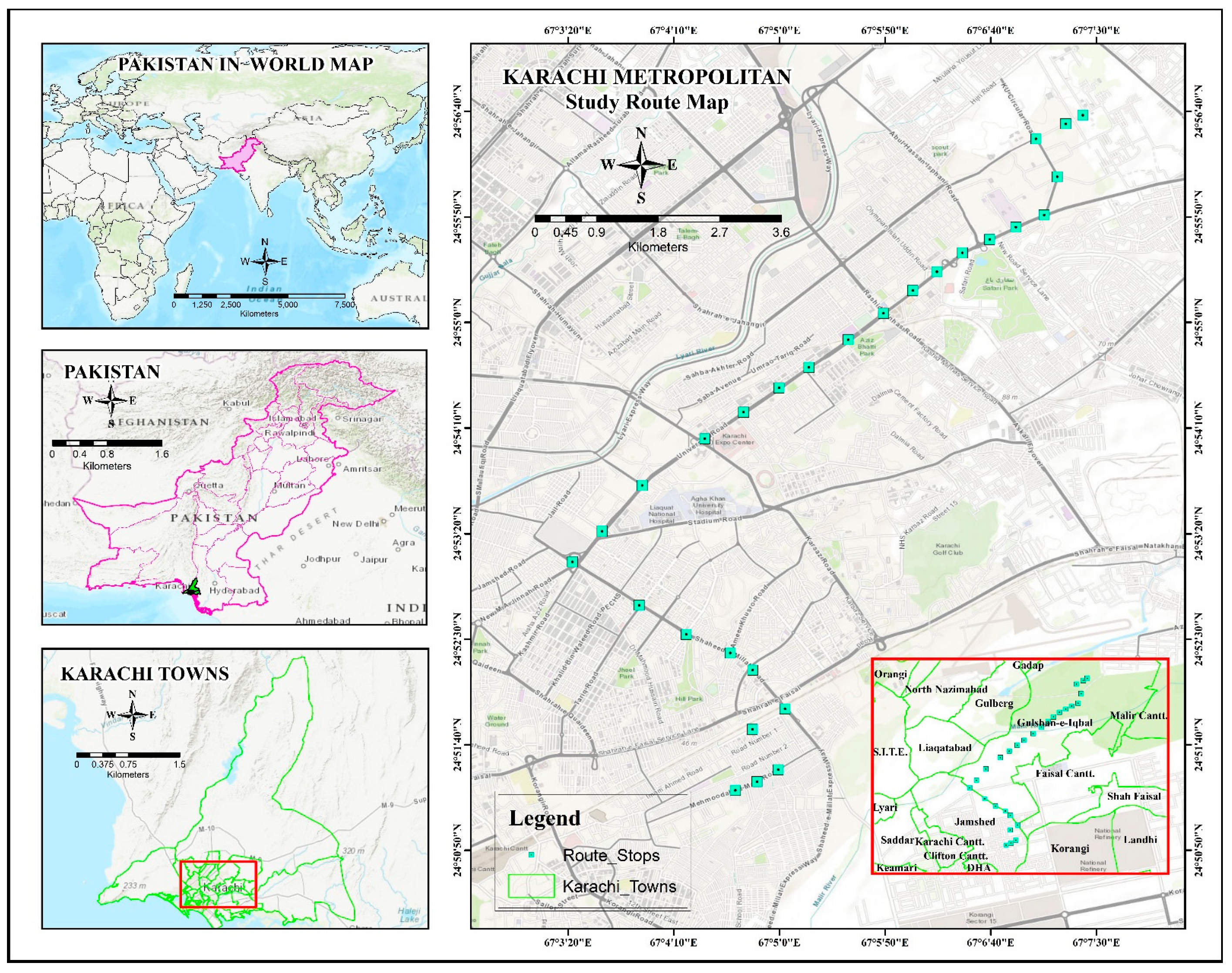
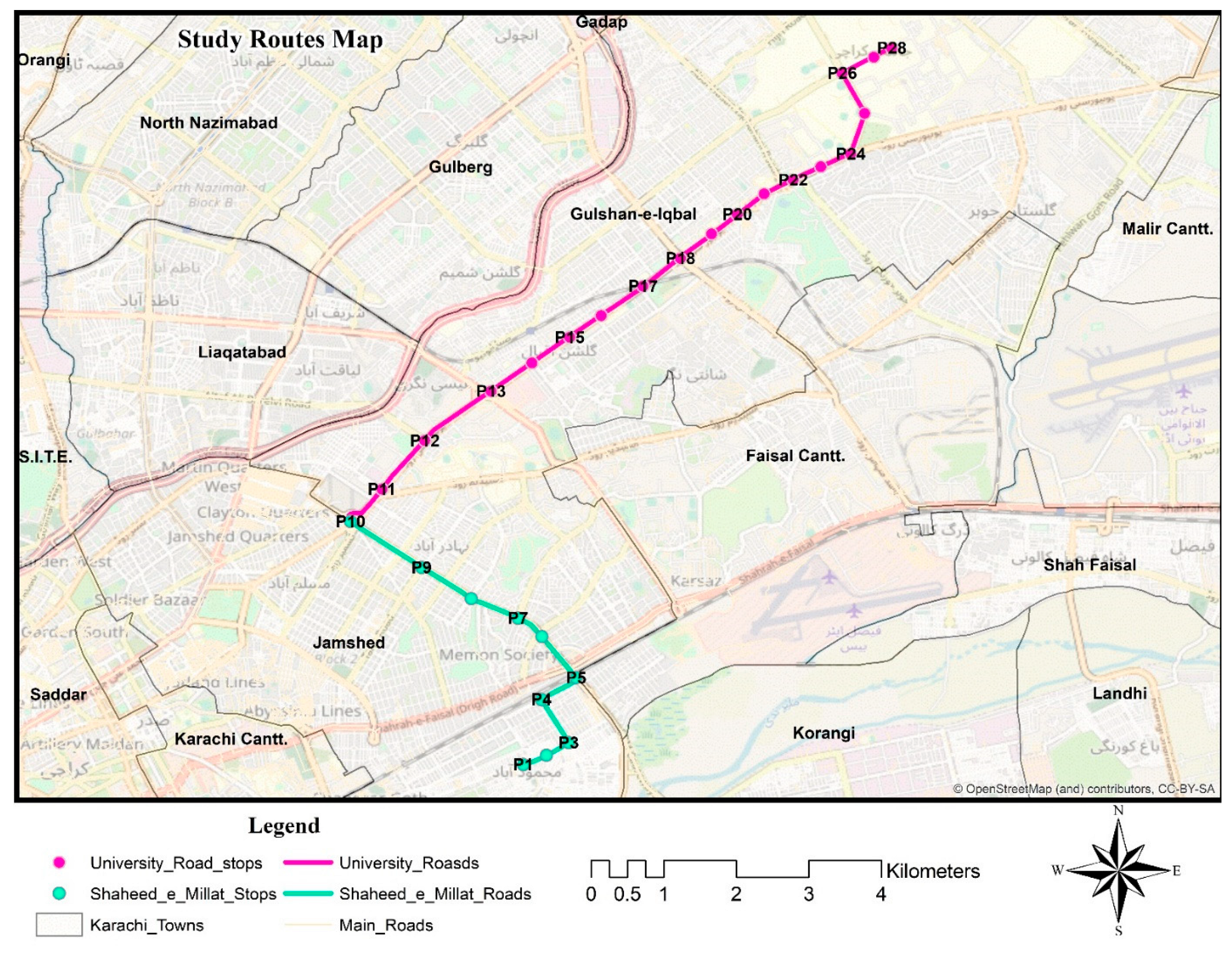
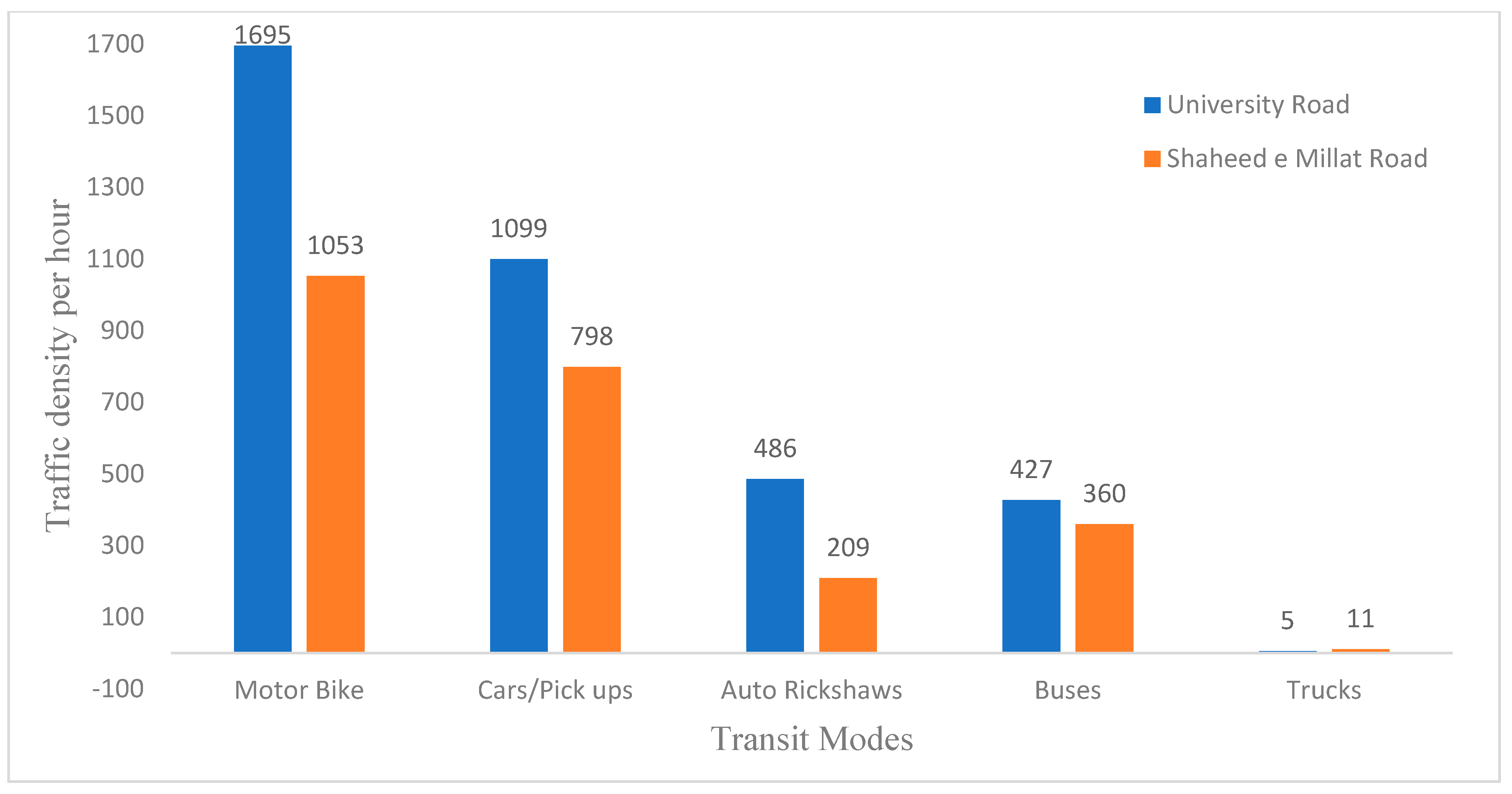
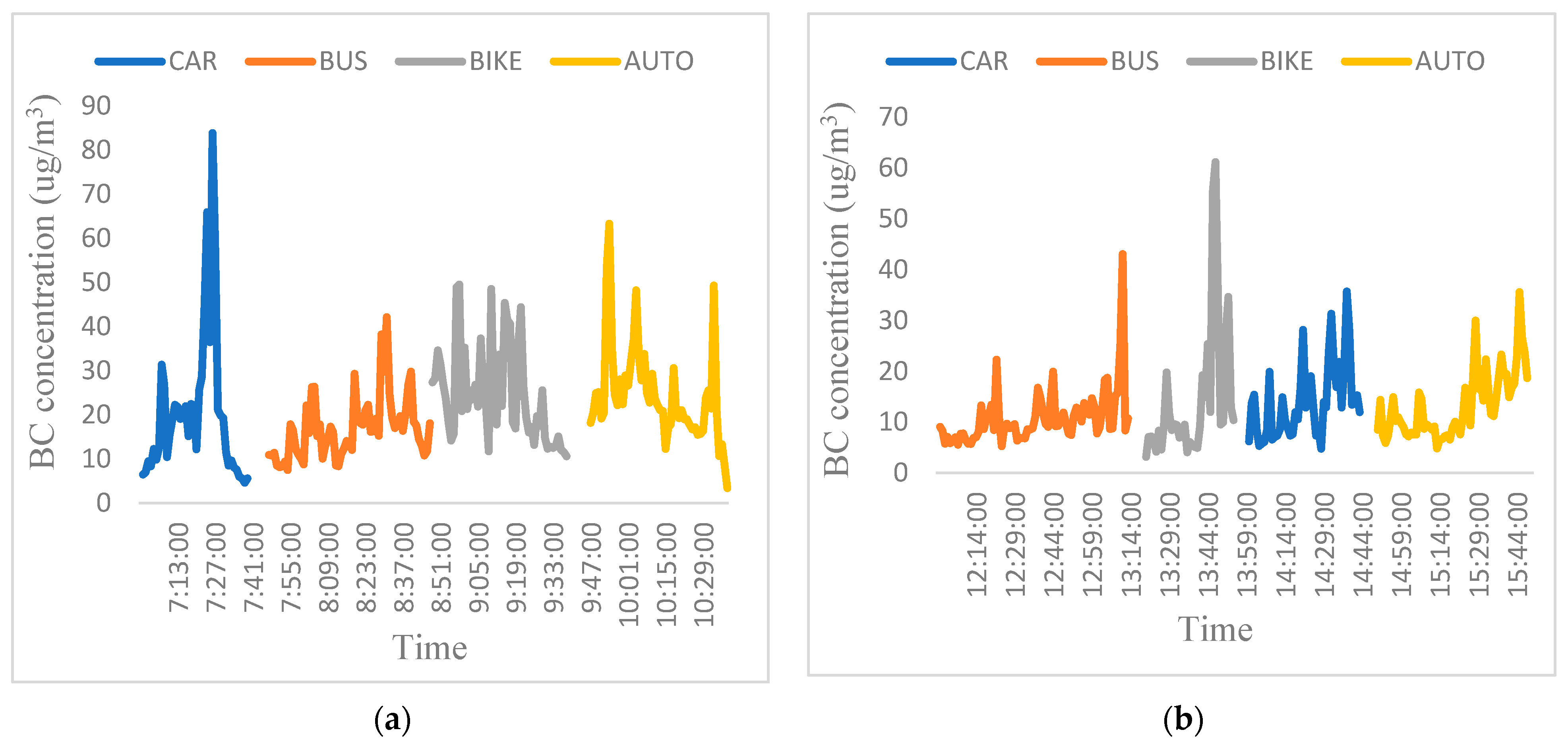
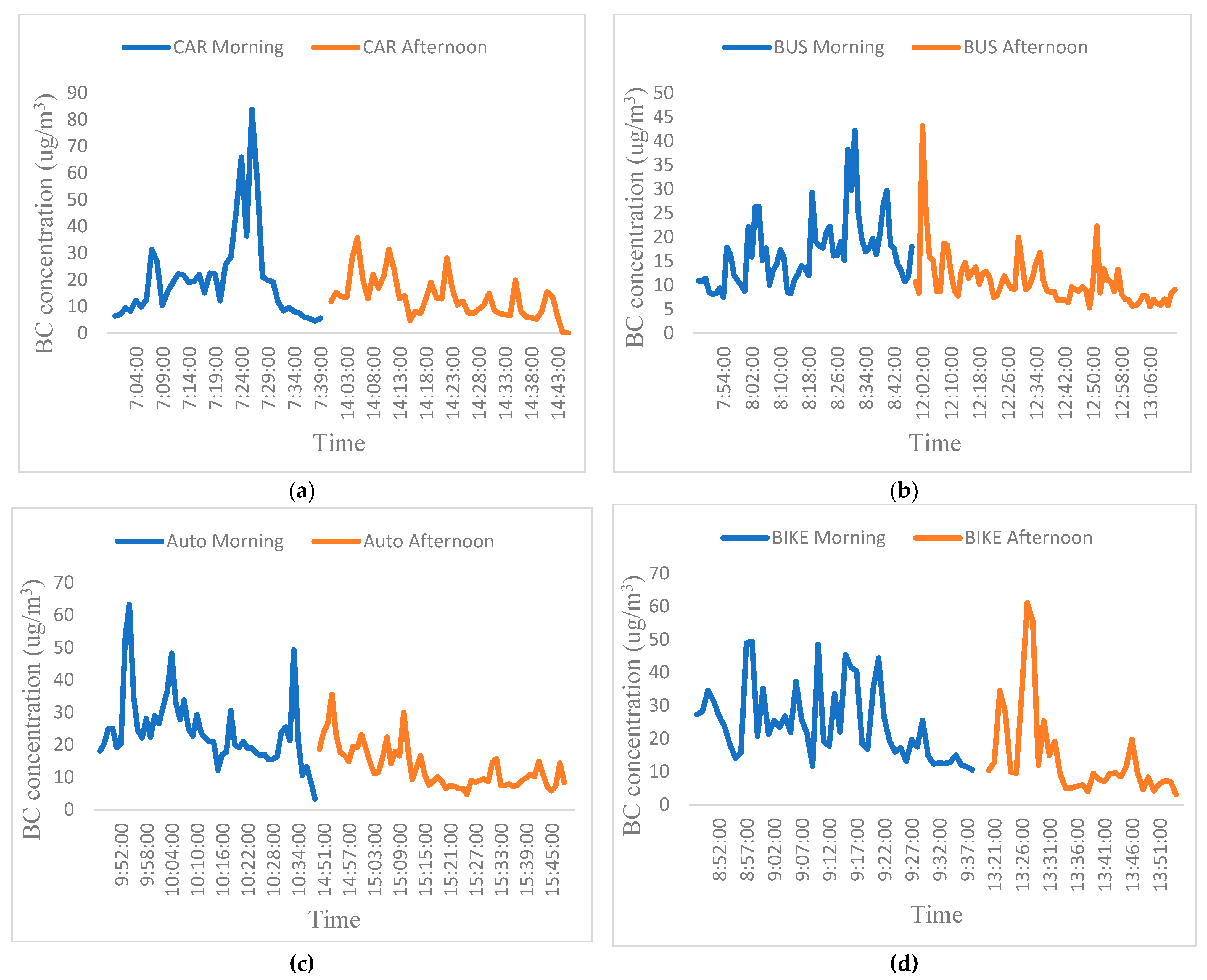
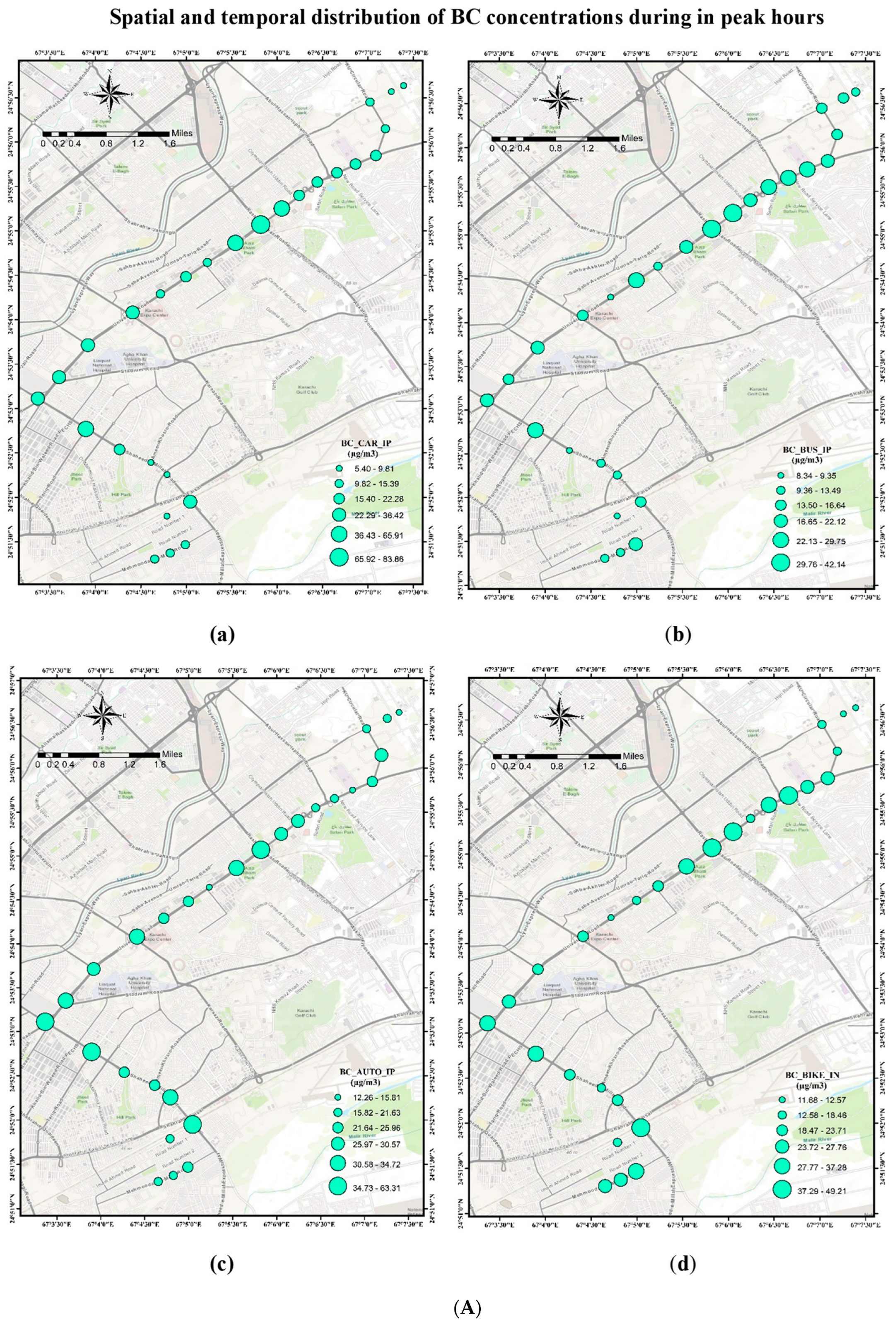

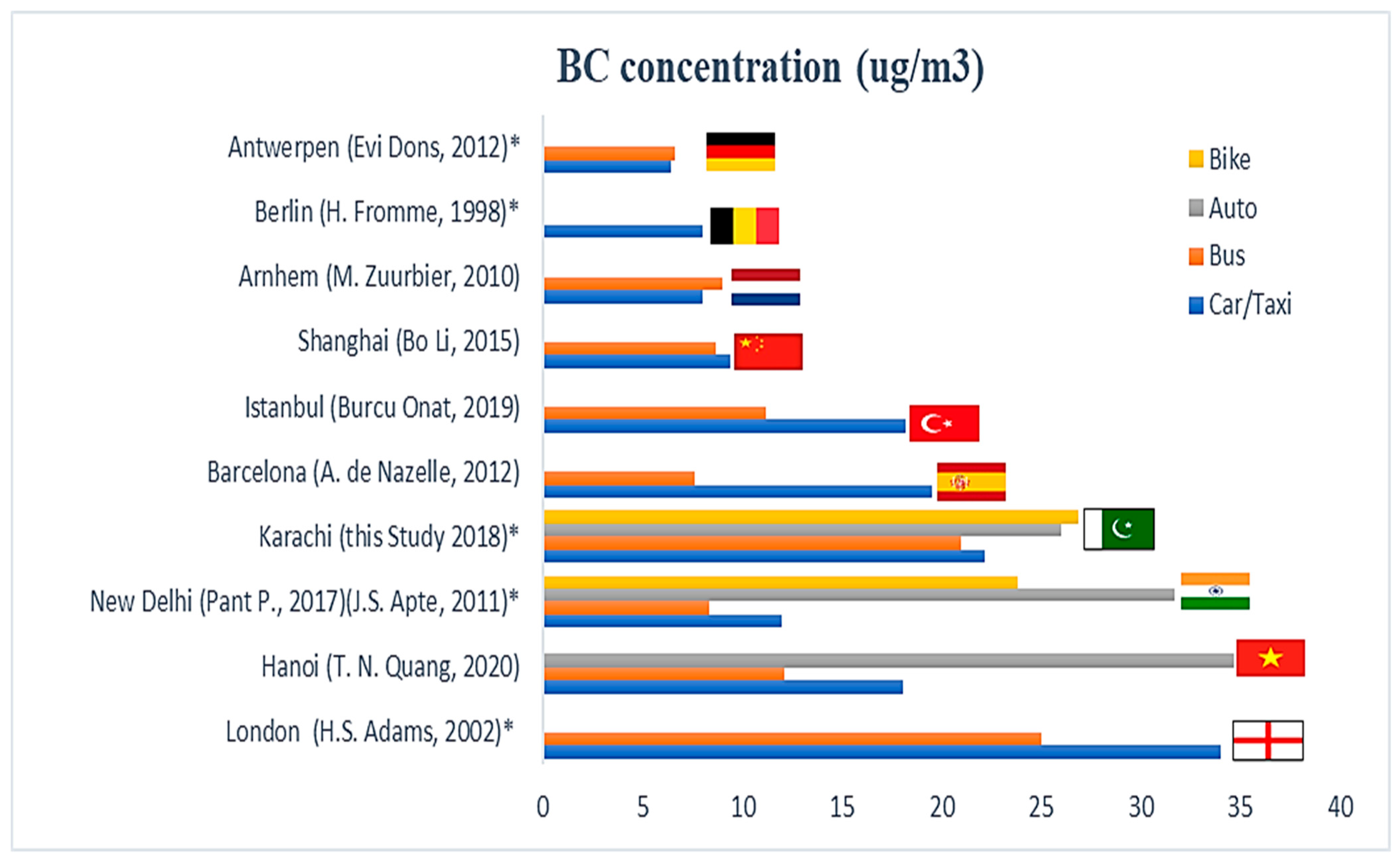
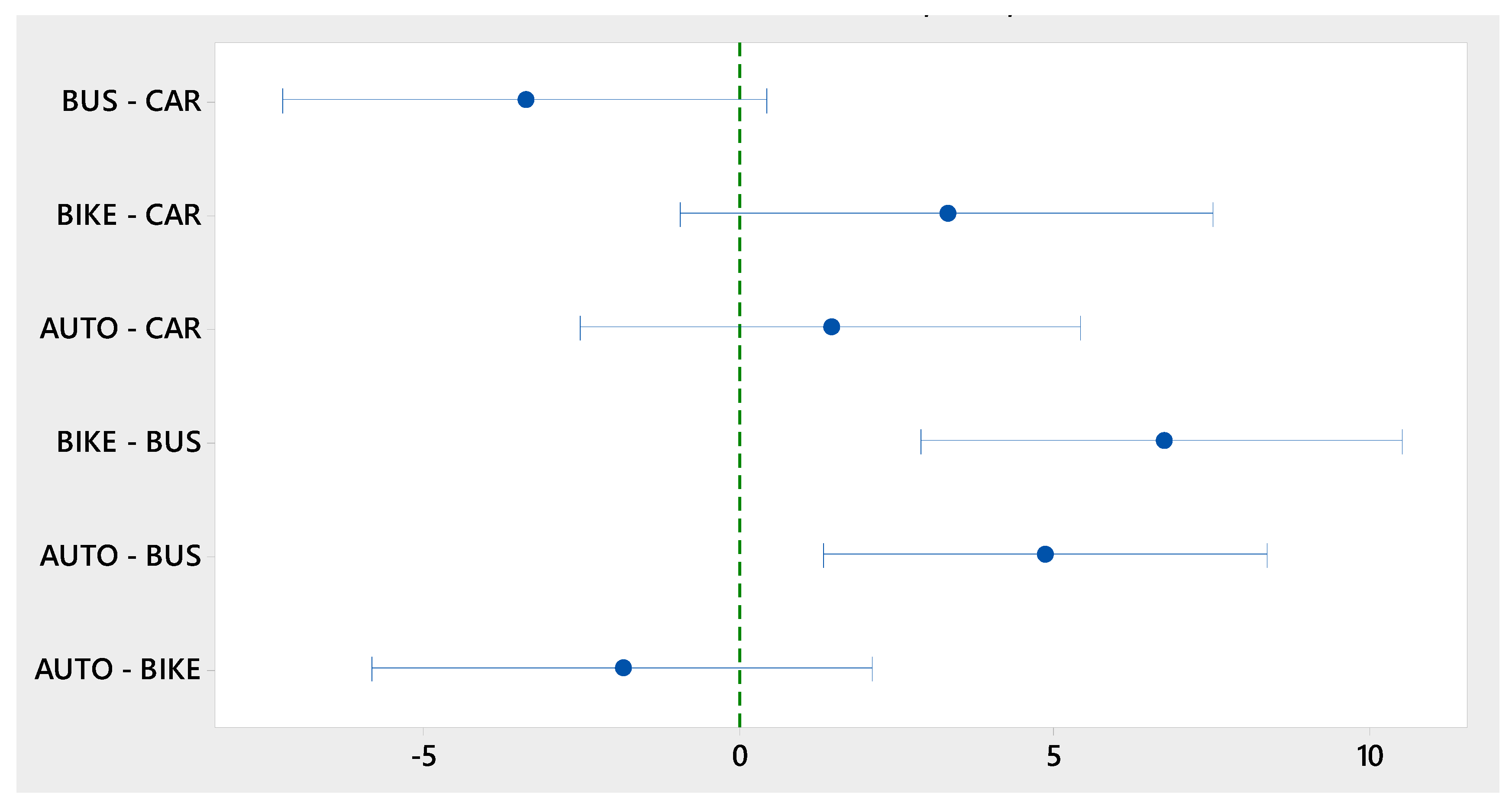
| Route | Length (km) | Lanes | Lane Width (m) | Intersections | U-Turns | Buildings | Average Vehicles Per Hour |
|---|---|---|---|---|---|---|---|
| Shaheed-e-Millat Road | 6.5 | 2–3 | 7–11 | 5 | 2 flyovers | Small to high rise residential buildings on both sides of road. | 2430.5 1 |
| University Road | 10.8 | 3–4 | 9–13 | 4 | 4 | 2–5 story residential + commercial buildings along with food streets, schools, colleges, universities, and parks. | 3710.5 |
| Travel Mode | Trips Per Week (N) | Time (min) | BC Exposure Mean ± SD (µg/m3) | Median | Range | Q1 | Q3 | IQR | Inhaled Dose Mean ± SD (µg/km) |
|---|---|---|---|---|---|---|---|---|---|
| In-Peak | |||||||||
| Car | 4 | 33 | 22.2 ± 4.31 | 17.15 | 79.27 | 8.69 | 22.38 | 13.70 | 0.57 ± 0.27 |
| Bus | 4 | 70 | 21.0 ± 2.17 | 16.118 | 34.659 | 11.257 | 19.215 | 7.958 | 1.13 ± 0.22 |
| Auto rickshaw | 4 | 60 | 26.0 ± 1.89 | 21.74 | 59.91 | 17.90 | 27.97 | 10.07 | 1.20 ± 0.19 |
| Motorbike | 4 | 30 | 26.9 ± 3.02 | 21.49 | 38.96 | 15.78 | 31.52 | 15.74 | 0.62 ± 0.12 |
| Off-Peak | |||||||||
| Car | 4 | 30 | 11.4 ± 2.58 | 12.87 | 30.92 | 7.77 | 16.85 | 9.09 | 0.27 ± 0.11 |
| Bus | 4 | 60 | 10.8 ± 5.46 | 9.139 | 37.815 | 7.714 | 12.666 | 4.952 | 0.50 ± 0.08 |
| Auto rickshaw | 4 | 50 | 14.2 ± 1.57 | 10.917 | 30.770 | 7.912 | 16.768 | 8.856 | 0.54 ± 0.16 |
| Motorbike | 4 | 25 | 15.0 ± 2.66 | 9.49 | 58.00 | 6.38 | 14.87 | 8.49 | 0.29 ± 0.24 |
| BC (μg/m3) | Temperature (°F) | Humidity (%) | Wind Speed (km/h) | Pressure (hPa) | |
|---|---|---|---|---|---|
| Temperature (⁰F) | 0.108 | ||||
| 0.023 | |||||
| Humidity (%) | −0.245 | 0.561 | |||
| 0.000 | 0.000 | ||||
| Wind Speed (Km/h) | 0.079 | −0.840 | −0.897 | ||
| 0.098 | 0.000 | 0.000 | |||
| Pressure (hPa) | 0.359 | −0.093 | −0.812 | 0.521 | |
| 0.000 | 0.052 | 0.000 | 0.000 |
Publisher’s Note: MDPI stays neutral with regard to jurisdictional claims in published maps and institutional affiliations. |
© 2022 by the authors. Licensee MDPI, Basel, Switzerland. This article is an open access article distributed under the terms and conditions of the Creative Commons Attribution (CC BY) license (https://creativecommons.org/licenses/by/4.0/).
Share and Cite
Javed, J.; Zahir, E.; Khwaja, H.A.; Khan, M.K.; Masood, S.S. Black Carbon Personal Exposure during Commuting in the Metropolis of Karachi. Atmosphere 2022, 13, 1930. https://doi.org/10.3390/atmos13111930
Javed J, Zahir E, Khwaja HA, Khan MK, Masood SS. Black Carbon Personal Exposure during Commuting in the Metropolis of Karachi. Atmosphere. 2022; 13(11):1930. https://doi.org/10.3390/atmos13111930
Chicago/Turabian StyleJaved, Javeria, Erum Zahir, Haider Abbas Khwaja, Muhammad Kamran Khan, and Saiyada Shadiah Masood. 2022. "Black Carbon Personal Exposure during Commuting in the Metropolis of Karachi" Atmosphere 13, no. 11: 1930. https://doi.org/10.3390/atmos13111930
APA StyleJaved, J., Zahir, E., Khwaja, H. A., Khan, M. K., & Masood, S. S. (2022). Black Carbon Personal Exposure during Commuting in the Metropolis of Karachi. Atmosphere, 13(11), 1930. https://doi.org/10.3390/atmos13111930







